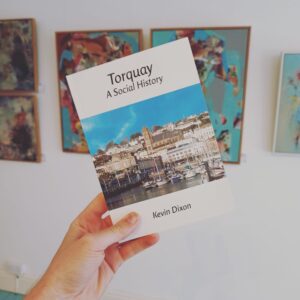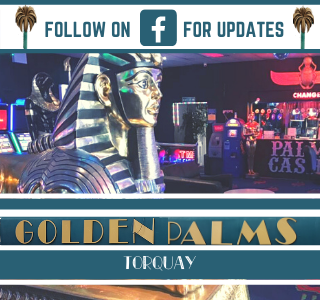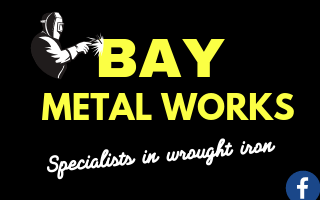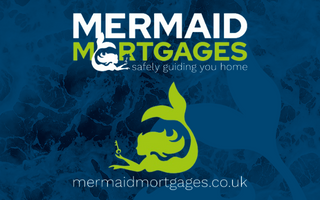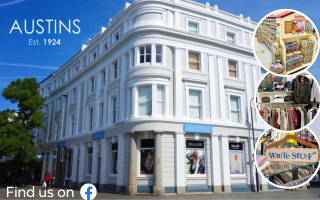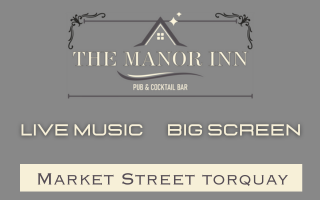Back in 1774 an Exeter printer by the name of Andrew Brice journeyed to the coast and found that “Tor Kay is a village and an inn or two”.
One of those harbourside inns, serving a population of around 500, was the Bird in the Hand. This is a traditional English pub name, said to derive from Henry VIII’s love of falconry.
Above the door was a hanging sign giving the pub’s name and its motto, “A bird in the hand is better far than two birds in the bushes are.” It was said that landlady Betty Cole would never give credit.
Torquay, however, was already beginning to see great changes, and by the 1850s the site was occupied by the more prestigious Wolfinden’s London Inn.
Park Lane is on the site of the eighteenth-century Old Inn and nineteenth century Gibbons Commercial Hotel
Another hostelry was the Old Inn. Following the same journey, the site became the Gibbons Commercial Hotel and is now Park Lane.
A little further along Victoria Parade was the Shallop Inn; a shallop was a coastal fishing boat. On the same location is now the Yacht, named after a pleasure craft, so suggesting the transition of a working fishing community into a leisure resort.
These are just a few examples of how Torquay’s pubs, their names, and their clientele, have changed over the decades. As the focus of a community, pubs have mirrored the town’s evolution from a collection of small hamlets to the richest town in Britain and then onward to the modern resort we know today.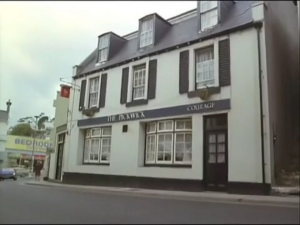
The Pickwick, now Twiggy’s
And there are a lot of local pubs to consider.
Over the past few hundred years we have at least 170 drinking and entertainment venue names recorded between Torre Station and the Strand. But do note that most of these have long closed or have been renamed, sometimes multiple times.
It’s believed that the origins and signage of taverns go back to the Romans who hung vine leaves outside their tabernae to inform the public that they sold wine. In Britain vine leaves were not easy to acquire so other vegetation was used instead. This tradition is said to come down to us in the Bay in pub names such as The Bull & Bush and Hop & Grapes.
As most people were illiterate publicans would later hang distinctive objects outside their inns and alehouses or just use pictures to identify their premises.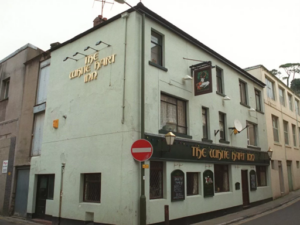
The White Hart, named after Richard III’s heraldic badge
Giving a name to a hostelry seems to have been established by the twelfth century, though hanging a sign outside a pub wasn’t compulsory until 1393. This was during the reign of King Richard II and many pubs adopted the King’s heraldic badge, the White Hart, while others used the image of a crown. Though Torquay is a relatively modern town, Torquay has had taverns called the White Hart and the Crown.
Alongside such country-wide customs, the resort’s pretentions are reflected in a high number of royal titles: the Prince Albert, Prince of Wales, Duke of York, Old Lion, Golden Lion, Royal Oak, Queens Arms, Royal Standard, Queen Victoria, George, Victoria and Albert, and Rising Sun (from the badge of Edward III).
In 1800 Torquay only had a population of around 800
Torquay’s population grew rapidly from around 800 in 1800 to 33,000 a century later, so most of our pubs are late Victorian or Edwardian. Nevertheless, much older traditions have been followed.
The Lansdowne. The first Marquess of Lansdowne served as Prime Minister
One of these is to use the titles of notable landowners, even those with limited connections to the Bay. And so, we have: the Lansdowne, Cary, Grafton, Clarence, Coburg, Melville, Brunswick, and Pembroke.
The Castle, Torquay’s oldest purpose-built surviving inn (1837) and once the most profitable pub in the whole of South Devon
A pub name may just tell you where it is. This could be related to a prominent local landmark such as the Castle, named after the Gothic building at the top of the hill.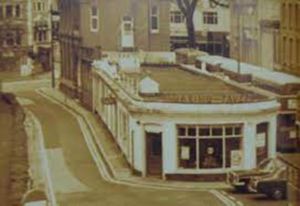
Torquay’s biker bar the Marine Tavern, in front of The Pavilion
Then there’s the Marine Tavern, Meadfoot, Torre Abbey, Fleet, Top of the Town, Upton Vale, and the Warren (near the Abbey’s mediaeval rabbit warrens on Warren Road). If you have ever ascended to the Alpine you’ll know why it had that name.
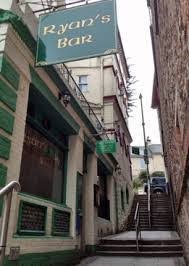 Ryan’s Bar, one of Torquay’s several London Inns
Ryan’s Bar, one of Torquay’s several London Inns
Travel is another theme. During the eighteenth and early nineteenth centuries a pub would advertise itself as a pickup point for coaches heading to a particular destination. So, we have the Bristolian, Exeter Inn, and there were at least three London Inns at one time or another (the Strand, Pimlico and Abbey Road).
Later in 1848 came the railway and the Railway Inn, promoting its proximity to Torre station.
As a way of attracting custom, many public houses chose to associate themselves with a predominant local trade. Craftspeople moving to an area would seek out such a pub and a workers’ community would form. So, we had the Mason’s Arms, Carpenter’s Arms, Printers Elbow, Post Horn.
We also had a couple of pubs called the Foresters Arms, linked to the Ancient Order of Foresters Friendly Society, formed in 1834, and known its for social and charitable work.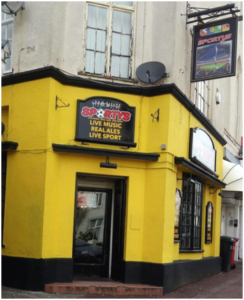
Great things happen in pubs. Torquay United was formed at the Torre Abbey Hotel on Monday 1 May 1899. The pub is now Sportys on Belgrave Road
Over the years some hostelries have had multiple name changes. For example, Torquay’s oldest purpose-built inn is the Castle (1837). It has been the Iron Bar, Plonkington’s Wine Bar, Chaplin’s, and is now back under its original name.
Close by was the Exeter Inn. In a quest for a new and affluent clientele the pub was renamed the Jolly Judge, Pig in Black, and then the Wig & Pen. The idea was that the legal profession working at the nearby magistrates’ court would adopt the venue. Sad to say the expected high-spending solicitors didn’t arrive in the expected numbers. On the other hand, some of their clients did. The court has since convened elsewhere, and the pub is now the Rabbit Hole.
As times change so do pub identities and names. This is particularly true in resort towns with new visitors arriving every few weeks expecting up-to-date experiences.
Especially on the Harbourside names consequently rapidly switch reflecting the latest drinking and partying trends. Long gone are Spartacus, Lazers, Stax, Zulus, MoJo’s, Mambos, Crazy Horse; and further up town, Blu Cargo, Bierkeller, Bluitts.
Since its very beginnings Torquay has impersonated other places. We are the Queen of the English Riviera and our architecture and culture has always mimicked sunnier shores. Hence, the Boulevard, El Sombrero, Cafe Royale, Bodega, Lautrec’s, Ibiza Bar, Piazza, Madeira, Mexican Bar, and many, often transient, others.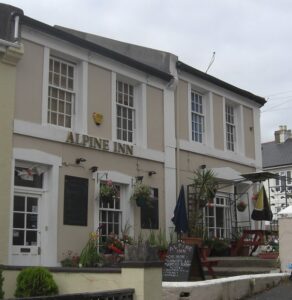
If you have ever ascended to the Alpine you’ll know why it had that name
The late twentieth century saw a variety of Irish and paired names. Locally we acquired Seamus O’Donnells, the Apple and Parrot, and Fox and Firkin.
While many of the town’s venues have long histories, every so often a bar is created from scratch and needs a name.
In 1989 Fleet Walk was opened with part of the new construction being the circular Wintergarden. In 2009 it was announced that the space would now be the home of a Wetherspoons, a chain known for converting unconventional premises into pubs.
As Wetherspoons are often named after noted locals, it was planned to name the new venture the Agatha Christie, themed around the celebrated, though teetotal, Torquay author. That was until the company controlling Dame Agatha’s estate became aware, raised objections, and the idea was dropped.
The fallback name came from the Wintergarden location, originally Abbey Place, a parade of businesses and hotels. One of these merchants was the grocer Slade and Sons, a local trader dating from 1837.
Torquay’s Green Ginger, named after Slade’s Green Ginger Wine, “a most delicious, safe and cooling beverage”
In 1846 an advert in the Torquay Directory announced to “The Nobility, Gentry and Public” that Stiven’s & Co had appointed “Mr JJ Slade as sole agent for their Green Ginger Wine … a most delicious, safe and cooling beverage in spring water, superior to any mixture yet introduced”.
Hence the new Wetherspoon became the Green Ginger.
Most of the pubs mentioned above won’t be familiar. Indeed, we may, sadly, be the last to experience the once ubiquitous, diverse, and life-enhancing great British pub. In 1980 there were 69,000 pubs across England and Wales. Today it’s less than 40,000. Enjoy them while you can.
Torquay: A Social History’ by local author Kevin Dixon is available for £10 from Artizan Gallery, Lucius Street, Torquay, or:
https://www.art-hub.co.uk/product-page/torquay-a-social-history-by-kevin-dixon





